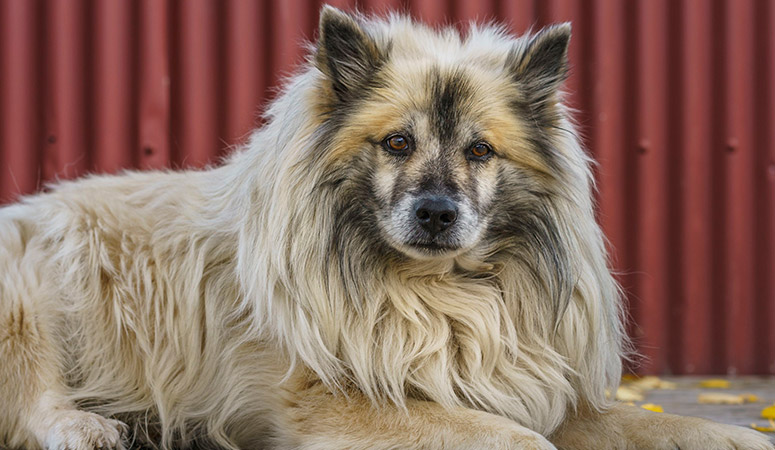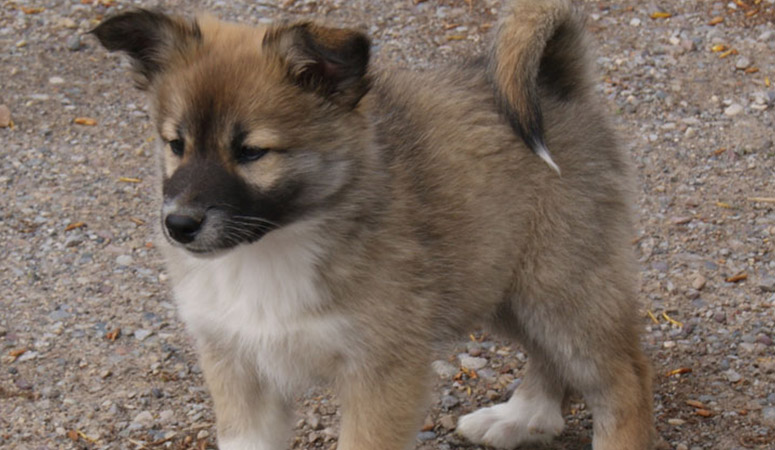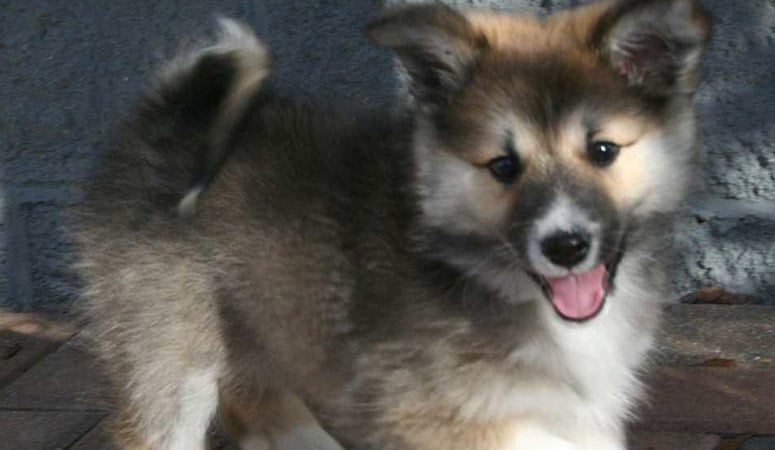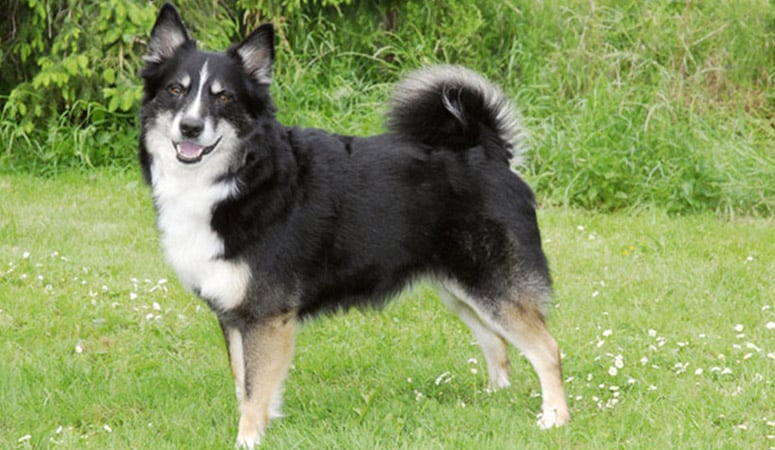Icelandic Sheepdog
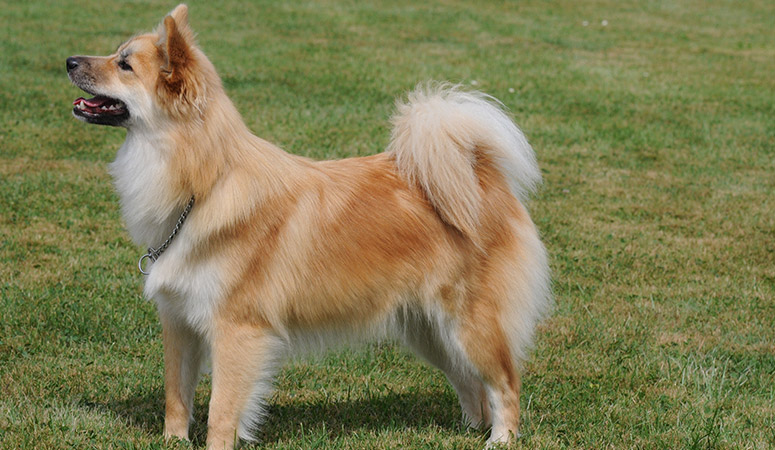
As Iceland’s only native dog breed, the Icelandic Sheepdog is commonly used to herd sheep in the Icelandic countryside with small-to-medium size. The breed has typical pricked ears, a curled, bushy tail, and a double, stand-off coat, which help insulate him against frigid weather. They are loyal, devoted, loving and friendly to their family.
| Other Names | Friaar Dog, Iceland Sheepdog,Iceland Dog, Icelandic Sheepdog, Islandsk Farehond, Islenskur Fjarhundur |
| Color | Black & White, Chocolate & White, Cream & White, Fawn & White, Gold & White, Gray & White, Red & White, Sable & White, Tan & White, White Tan & Black |
| Height | Males: 17-19 inches. Females: 15-17 inches. |
| Weight | Males: 20-30 pounds. Females: 20-30 pounds. |
| Life Span | 12-14 years |
| Personality | Friendly, Playful, Inquisitive |
| Exercise | Needs Lots of Activity |
| Origin |
| Popularity | #132 |
| Groom Needs | Weekly Brushing |
| Kids Friendly | Yes |
| Dog Friendly | Yes with supervision |
| Watch Dog | |
| Family Dog | Yes |
| Litter Size | 4 to 8 puppies |
Icelandic Sheepdog Pictures
Icelandic Sheepdog Video
Introduction
The Icelandic Sheepdogs are the only indigenous dogs of Iceland. With the pricked ears, docked tails, and an expression of happiness, the Icelandic Sheepdog appears so relatable, you’d think there’s nowhere else it’d rather be than with you. Balanced on hindlegs that bear one or two dewclaws, the Icelandic struts about with elegance and agility, covering grounds effortlessly. They have two coat length varieties — long and short– both of which are thick and waterproof. Icelandic Sheepdogs come in a wide variety of colors including tan, gray, chocolate, black, reddish-brown, and white.
A standard male of this breed stands 17-19 inches at the shoulder and weighs about 30 pounds. A similar female would measure up to 17 inches in height taken from shoulder to paw and is likely to tip the weighing scales at 25 pounds. Icelandic Sheepdogs are rambunctious dogs with an average life expectancy of 11-14 years.
Living with Icelandic Sheepdog
The Icelandic’s coat of many colors can be short or long, with both lengths having an outer coat and an undercoat. Icelandic Sheepdogs shed a fair amount, even more so during shedding season, which occurs twice a year. Any tangles can be worked out with a slicker brush or metal comb.
Be sure you have a good vacuum cleaner to keep your home tidy. Icie lovers say he doesn’t shed as much as you might think, but don’t get this breed thinking that he is a low shedder.
Brush the Icie’s coat once or twice a week to remove loose fur and reduce the amount of hair you find floating around the house or attached to your clothes.
As with all breeds, the nails should be trimmed regularly, as overly long nails can be painful to the dog. You may also want to clip the tufts of hair between the toes, but other than that, the coat needs no trimming.
Brush the teeth often with a vet-approved pet toothpaste to keep good overall health and fresh breath.
An athletic and energetic dog, you’ll need to make sure that your Icelandic Sheepdog gets plenty of exercises. This ensures that he stays healthy and happy.
Icelandic Sheepdogs enjoy outdoor activities and make great companions on long walks or hikes. Moderate exercise every day will help keep them healthy and happy. This can come in the form of long walks, hikes, jogs and play sessions.
The breed also exercises mind and body by participating in canine sports such as obedience, herding, tracking, agility, rally, and other activities that can be enjoyed by dog and owner.
It’s helpful to have an enclosed yard where they can run and play catch and otherwise expend excess energy. He loves to hang with his friends at the dog park or play endless games of fetch.
The Icelandic Sheepdog does well on a diet of high-quality dry kibble. But they should be fed a diet appropriate to the dog’s age, size, activity level and metabolism. Because this is an active breed, make sure your dog gets enough to eat and keep his energy level up.
The quality of dog food you buy also makes a difference — the better the dog food, the further it will go toward nourishing your dog. Talk to your veterinarian about the optimal diet and quantity of food for your Icelandic Sheepdog.
Some dogs are prone to getting overweight, so watch your dog’s calorie consumption and weight level. Treats can be an important aid in training, but giving too many can cause obesity.
Clean, fresh water should always be available.
Learn about which human foods are safe for dogs, and which are not. Check with your vet or the dog’s breeder if you have any questions or concerns about your dog’s weight or diet.
Icelandic Sheepdogs are generally very healthy dogs. But they can be prone to a few health conditions, such as hip dysplasia, elbow dysplasia and patellar luxation.
Some health problems don’t appear until a dog reaches full maturity. Not all Icelandic Sheepdogs will get any or all of these diseases, but it’s important to be aware of them if you’re considering this breed.
An Icelandic’s ears should be checked regularly for signs of infection, and the teeth should be brushed often, using a toothpaste designed for dogs.
There are several health tests considerations specific to the breed, such as hip evaluation and ophthalmologist evaluation.
Responsible breeders test all breeding stock for conditions that can affect the breed. Regular visits to the vet for checkups and parasite control help to ensure the dog a long, healthy life.
Total Annual Cost: $2889
Cost is estimated for the first year and may vary depending on many factors, such as dog food, health care, leash, collar, licensing, possible fencing, crates, training and obedience classes, dog-walking, grooming, treats, toys, flea, tick, and heart-worm meds, microchips, etc.
Add intelligence and a willingness to learn, and you’ve got a very trainable breed on your hands. A joy to train, you’ll find that the Icelandic Sheepdog is eager to please.
Early socialization and puppy training classes are recommended and help to ensure that the Iceland Sheepdog grows into a well-adjusted, well-mannered companion.
They love being the center of their family and are unhappy if they are regularly left alone for long periods of time.
You should keep up training even after the basics have been mastered, as this dog wants to be challenged with a variety of different training, exercise and play tasks. Keep in mind that they don’t respond well to harsh corrections or training methods.
It helps keep them active and out of trouble. Feel free to mix it up with your training activities, which will ensure that your dog is always on his toes and learning as much as possible.
History
The Icelandic Sheepdog is a spitz-type dog used for herding in ancient Scandinavia, where it is thought to have originated. It closely resembles the dog types that domiciled graveyards in Denmark and Sweden around 8000 B.C. Some authorities claim that when the Vikings invaded Iceland around the 800s A.D, they brought their dogs along with them. These imported dogs are believed to have been descendants of the Icelandic Sheepdog. The Icelandic Sheepdog is also thought to be closely related to the Shetland Sheepdog, Welsh Corgi, and Norwegian Buhund, and they were reared to herd sheep and livestock in the country area of Iceland.
Icelanders have been dog lovers from about 1,000 years ago when the Norse dwellers had probably come into the area. Some accounts claim that the Nordic people had imported their dogs when they created the Scandinavian country. Such accounts attribute these dogs to the Icelandic Sheepdog. The Icelandic Sheepdogs have witnessed an interesting history, meeting face-to-face with extinction along the way. Around the 10th century, the insurgency of famine had almost wiped out the population of Icelandic Sheepdogs in their home country. This was regarded as the most devastating epidemic in the history of the dog until the deadlier case of the 1850s when the breed was reduced to less than 25% of its initial population. Sequel to this, importation of dogs into Iceland was controlled and limited by order.
In 1901, dog imports into Iceland were banned and later in 1969 a breed club, the Icelandic Kennel Club, was founded to keep an eye on the breed. The Icelandic Sheepdog was officially recognized by the American Kennel Club (AKC) in 2010.
Helpful Information
Breed Club: ICELANDIC SHEEPDOG ASSOCIATION OF AMERICA
Breed Club Link: http://icelanddogs.com/
Breed Club Rescue: National Icelandic Sheepdog Rescue Alliance
Breed Club Rescue Link: http://www.nationalicelandicsheepdogrescuealliance.org/index.htm

